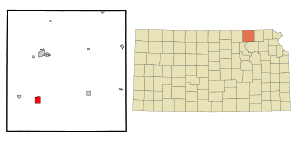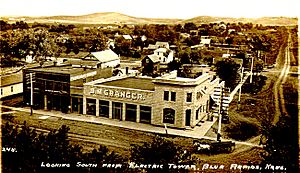Blue Rapids, Kansas facts for kids
Quick facts for kids
Blue Rapids, Kansas
|
|
|---|---|

(February 2014)
|
|

Location within Marshall County and Kansas
|
|

|
|
| Country | United States |
| State | Kansas |
| County | Marshall |
| Founded | 1869 |
| Incorporated | March 20, 1872 |
| Area | |
| • Total | 2.00 sq mi (5.19 km2) |
| • Land | 1.99 sq mi (5.14 km2) |
| • Water | 0.02 sq mi (0.05 km2) |
| Elevation | 1,158 ft (353 m) |
| Population
(2020)
|
|
| • Total | 928 |
| • Density | 464.0/sq mi (178.81/km2) |
| Time zone | UTC-6 (CST) |
| • Summer (DST) | UTC-5 (CDT) |
| ZIP code |
66411
|
| Area code | 785 |
| FIPS code | 20-07650 |
| GNIS ID | 2394205 |
Blue Rapids is a small city in Marshall County, Kansas, United States. It's a friendly place with a rich history. In 2020, about 928 people lived there. The city is known for its natural beauty and interesting past events.
Contents
History of Blue Rapids
How Blue Rapids Started
People first tried to build a town here in 1857. But that attempt didn't work out. Then, in 1869–1870, about 50 families from New York moved to the area. They bought land and water rights. This group helped start the community we know today.
The Blue Rapids Town Company was formed. By the end of 1870, about 250 people lived there. Blue Rapids officially became a city in 1872.
Early Projects and Power
In 1870, some big projects began. Workers built a stone dam and an iron bridge on the Big Blue River. They also added a hydroelectric power plant. This plant used water to make electricity for factories and the town. Sadly, a flood in 1903 destroyed the power plant.
In the late 1800s and early 1900s, there were four gypsum mines nearby. Gypsum is a mineral used in building materials. The city's population grew a lot, reaching over 1,750 people around 1910.
Oldest Library and New Discoveries
Blue Rapids is home to a very special public library. It was built in 1875. This library is the oldest one west of the Mississippi that has been open continuously in the same building. That's a long time!
An important scientific discovery happened here. In the late 1950s, scientists found a special bacterium in soil from Blue Rapids. This bacterium later helped create a medicine used in health research.
Baseball History
Blue Rapids has a unique claim to fame in sports. It says it's the smallest town in the U.S. to host a national league baseball game. On October 24, 1913, over 3,000 fans came to watch. The Chicago White Sox and New York Giants played an exhibition game. This game was part of their world tour. The local ball field they played on is still used today!
Modern Updates and Ice Age Monument
In 2001, Blue Rapids got a new NOAA Weather Radio transmitter, KZZ67. This helps provide important weather and emergency information. It comes from the National Weather Service in Topeka, Kansas.
In 2012, a special monument was built in the town square. It's called "The Monument to the Ice Age." This monument teaches about the Ice Age. It explains how glaciers brought rocks and shaped the land. Blue Rapids has many natural resources because of these ancient glaciers. The monument celebrates this amazing geological history.
Geography of Blue Rapids
Where is Blue Rapids?
Blue Rapids is located in northeast Kansas. It's near where the Little Blue and Big Blue rivers meet. The city sits about 1,150 feet (351 meters) above sea level.
You can find Blue Rapids on highway US-77/K-9. It's about 5 miles (8 km) east of Waterville. The county seat, Marysville, is 12 miles (19 km) north. Frankfort is 13 miles (21 km) west. And the larger university town of Manhattan is 46 miles (74 km) north.
Land and Water
The city covers a total area of about 2.01 square miles (5.21 square kilometers). Most of this area, about 1.99 square miles (5.15 square kilometers), is land. A small part, about 0.02 square miles (0.05 square kilometers), is water.
Near Blue Rapids, the company Georgia-Pacific has a gypsum mine. This mine contains some of the purest gypsum in the world.
Population of Blue Rapids
| Historical population | |||
|---|---|---|---|
| Census | Pop. | %± | |
| 1870 | 250 | — | |
| 1880 | 829 | 231.6% | |
| 1890 | 936 | 12.9% | |
| 1900 | 1,100 | 17.5% | |
| 1910 | 1,756 | 59.6% | |
| 1920 | 1,534 | −12.6% | |
| 1930 | 1,465 | −4.5% | |
| 1940 | 1,433 | −2.2% | |
| 1950 | 1,430 | −0.2% | |
| 1960 | 1,426 | −0.3% | |
| 1970 | 1,148 | −19.5% | |
| 1980 | 1,280 | 11.5% | |
| 1990 | 1,131 | −11.6% | |
| 2000 | 1,088 | −3.8% | |
| 2010 | 1,019 | −6.3% | |
| 2020 | 928 | −8.9% | |
| U.S. Decennial Census | |||
What the 2020 Census Shows
The 2020 United States census counted 928 people living in Blue Rapids. There were 376 households and 243 families. The population density was about 467.5 people per square mile.
Most of the people, about 95.37%, were white. About 1.62% of the population was Hispanic or Latino.
About 23.4% of the people were under 18 years old. About 24.7% were 65 years or older. The average age in the city was 43.6 years.
What the 2010 Census Showed
In 2010, the census counted 1,019 people in Blue Rapids. There were 415 households. The population density was about 512.1 people per square mile.
About 97.2% of the people were White. About 1.4% were Hispanic or Latino.
About 29.9% of households had children under 18. The average age in the city was 43.2 years.
Education in Blue Rapids
Local Schools
The community of Blue Rapids is served by the Valley Heights USD 498 public school district. Students attend Valley Heights Jr/Sr High School. This school is located between Blue Rapids and its nearby town, Waterville. The school's mascot is the Mustangs!
School History
Blue Rapids High School used to exist but closed due to school unification. The Blue Rapids Pirates, the old high school team, won the Kansas State High School boys class B Track & Field championship in 1942.
See also
 In Spanish: Blue Rapids (Kansas) para niños
In Spanish: Blue Rapids (Kansas) para niños


